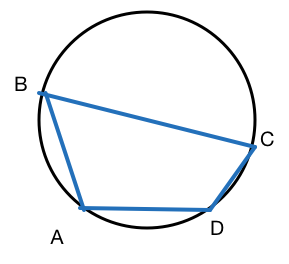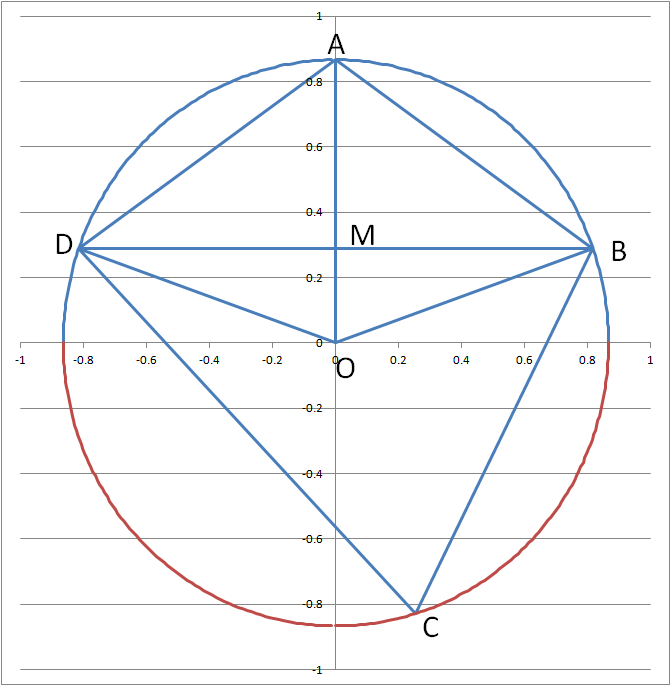It will all click together
 Suppose a cyclic quadrilateral
A
B
C
D
is such that
Suppose a cyclic quadrilateral
A
B
C
D
is such that
(i) A B = A D = 1 ,
(ii) C D = cos ( ∠ A B C ) and
(iii) cos ( ∠ B A D ) = − 3 1 .
Let R be the radius of the circle in which A B C D is inscribed. Find ⌊ 1 0 0 0 ∗ R ⌋ .
The answer is 866.
This section requires Javascript.
You are seeing this because something didn't load right. We suggest you, (a) try
refreshing the page, (b) enabling javascript if it is disabled on your browser and,
finally, (c)
loading the
non-javascript version of this page
. We're sorry about the hassle.
5 solutions
Actually the information given in ( i i ) is unnecessary.
Log in to reply
Yes, this could have been a more interesting question if I had asked for either the length of C D or the area of A B C D instead. A misfire on my part. :( Anyway, thanks for posting your solution. :)
Log in to reply
You could always post that version of the question as a follow up :)
Same way as I did it.
First, using the Cosine rule we have that
( B D ) 2 = ( A B ) 2 + ( A D ) 2 − 2 ∗ ( A B ) ∗ ( A D ) ∗ cos ( ∠ B A D ) =
2 − 2 ∗ ( − 3 1 ) = 3 8 ⟹ B D = 3 8 .
Now let C D = cos ( ∠ A B C ) = x . Since A B C D is cyclic we have that
cos ( ∠ A D C ) = − cos ( ∠ A B C ) = − x and
cos ( ∠ B C D ) = − cos ( ∠ B A D ) = 3 1 .
Next, since Δ A B C and Δ A D C have chord A C in common, we can use the Cosine rule to set up the following equation:
1 2 + x 2 − 2 ( 1 ) ( x ) cos ( ∠ A D C ) = 1 2 + ( B C ) 2 − 2 ( 1 ) ( B C ) cos ( ∠ A B C )
⟹ 1 + x 2 − 2 x ∗ ( − x ) = 1 + ( B C ) 2 − 2 ( B C ) ( x )
⟹ ( B C ) 2 − 2 x ∗ ( B C ) − 3 x 2 = 0 ⟹ ( B C − 3 x ) ( B C + x ) = 0 . .
Now since B C > 0 we have that B C = 3 x . But since the sides D C and B C are in the ratio x : 3 x ⟹ 1 : 3 and cos ( ∠ B C D ) = 3 1 we can conclude that Δ B C D is a right triangle with ∠ B D C = 9 0 ∘ . This implies that B C is a diameter of the circle in which A B C D is inscribed.
Using Pythagoras, we then have that
( B C ) 2 = ( C D ) 2 + ( B D ) 2 ⟹ 9 x 2 = x 2 + 3 8 ⟹ x 2 = 3 1 ,
and since x > 0 we have that B C = 3 x = 3 .
Thus R = 2 B C = 2 3 = 0 . 8 6 6 0 2 5 4 . . . . , and so ⌊ 1 0 0 0 ∗ R ⌋ = 8 6 6 .
You also can use coordinate geometry to solve it and the best thing about that is that point C is unnecessary to find the answer.
Log in to reply
Uneccasarily lenghty solution , we don't even need line (ii) for determining the radius.
Log in to reply
Yes, I see that now. This started out as a problem that involved proving that side B C was a diameter of the circle, but to post this as a question I had to have a numerical answer, so I asked for the radius. This was a bad choice, since the radius can be found easily using just two pieces of the information provided. I should have asked for either the length of side C D or the area of the quadrilateral to make it a more interesting question requiring all three pieces of information. Oh well ..... :(
I also did it via same method sir !
Haha. Oh, right. I see that now. I should have asked for the area of A B C D ; that would have made the question a bit more interesting. :)
Log in to reply
Area would be even more easier.
Log in to reply
@Krishna Sharma – easier*, not more easier.
@Krishna Sharma – I suppose. We could just break the quadrilateral up into three triangles that share the midpoint of B C , (i.e., the center of the circle), as a common vertex. After finding the side lengths, and establishing that B C is indeed a diameter, we could then just apply Heron's formula three times and add the resulting values.
Log in to reply
@Brian Charlesworth – There is a formula for area of cyclic quadrilateral
Δ = ( s − a ) ( s − b ) ( s − c ) ( s − d )
Where s = 2 a + b + c + d
Log in to reply
@Krishna Sharma – I guess I should have known that, but I didn't, so thanks for letting me know. I see that when d → 0 we end up with Heron's formula, as would be expected.
Let the circumcenter be O and ∠ B A D = α . Using Cosine Rule, we have:
B D 2 = 1 + 1 − 2 ( − 3 1 ) = 3 8 ⇒ B D = 2 3 2
Since △ A B D is an isosceles triangle, O must be on the perpendicular from A to B D (see figure below). Let the foot of the perpendicular be M . Then we note that:
O B 2 = O M 2 + B M 2 ⇒ R 2 = ( R − A M ) 2 + B M 2
We note that:
B M = 2 1 B D = 3 2
A M 2 = A B 2 − B D 2 = 1 − 3 2 = 3 1 ⇒ A M = 3 1
⇒ R 2 = ( R − A M ) 2 + B M 2 = ( R − 3 1 ) 2 + 3 2
⇒ R 2 = R 2 − 3 2 R + 3 1 + 3 2 ⇒ R = 2 3
⇒ ⌊ 1 0 0 0 ∗ R ⌋ = 8 6 6

If Someone Knows The Formula for Circum-Radius of an Triangle Then It would be more Easy . However it is Not Pure Mathematical , (Because We Use Just Known Formula) But Brian Sir's Solution is Pure Mathematical . But for Sake of Variety :
Using Cosine Rule , in Triangle ABD ; ( B D ) 2 = ( A B ) 2 + ( A D ) 2 − 2 × ( A B ) × ( A D ) × cos ( ∠ B A D ) B D = 2 3 2 . Using Standard formulas : R = 4 Δ a b d Δ = S ( S − a ) ( S − b ) ( S − d ) a = 2 3 2 , b = 1 , d = 1 , S = 1 + 3 2 S − a = 1 − 3 2 , S − b = 3 2 , S − d = 3 2 ∴ Δ = ( 1 + 3 2 ) ( 1 − 3 2 ) ( 3 2 ) ( 3 2 ) = 3 2 ∴ R = 2 3 A n s . .
Uneccasarily lengthy solution, no need to apply formula for circumradius.
Log in to reply
Well It Takes Maximum to maximum 1.5 Minute , So I don't Think That it is Lengthy , But I agree That Dieuler Oliveira Solution is Best :)
Let B D be x and angle BAD be q, apply cosine rule,
Cos q = (1^2 + 1^2 - x^2)/ [2 (1)(1)] = -1/ 3 {The Cosine angle of a Tetrahedron.}
=> x^2 = 8/ 3.
Cos (2 Pi - 2 q) = (R^2 + R^2 - x^2)/ (2 R^2) = 1 - x^2/ (2 R^2)
R^2 = (x^2/ 2)/ (1 - Cos 2 q) = [(8/ 3)/ 2]/ [1 - (-7/ 9)] = 3/ 4
As Cos 2 q = 2 (Cos q)^2 - 1 = 2/ 9 - 9/ 9 = -7/ 9
R = Sqrt (3)/ 2 = 0.86602540378443864676372317075294
Floor (1000 R) = 866
Let ∠ B A D = α . Triangle ABD is isosceles, so ∠ A D B = ∠ A B D = 9 0 º − 2 α and sin ( 9 0 º − 2 α ) = cos ( 2 α ) .
Now we calculate cos ( 2 α ) = 2 1 + cos α ⇒ cos ( 2 α ) = 3 3
By using Law of sines:
cos 2 α 1 = 2 R ⇒ R = 2 3
∴ ⌊ 1 0 0 0 R ⌋ = 8 6 6 .